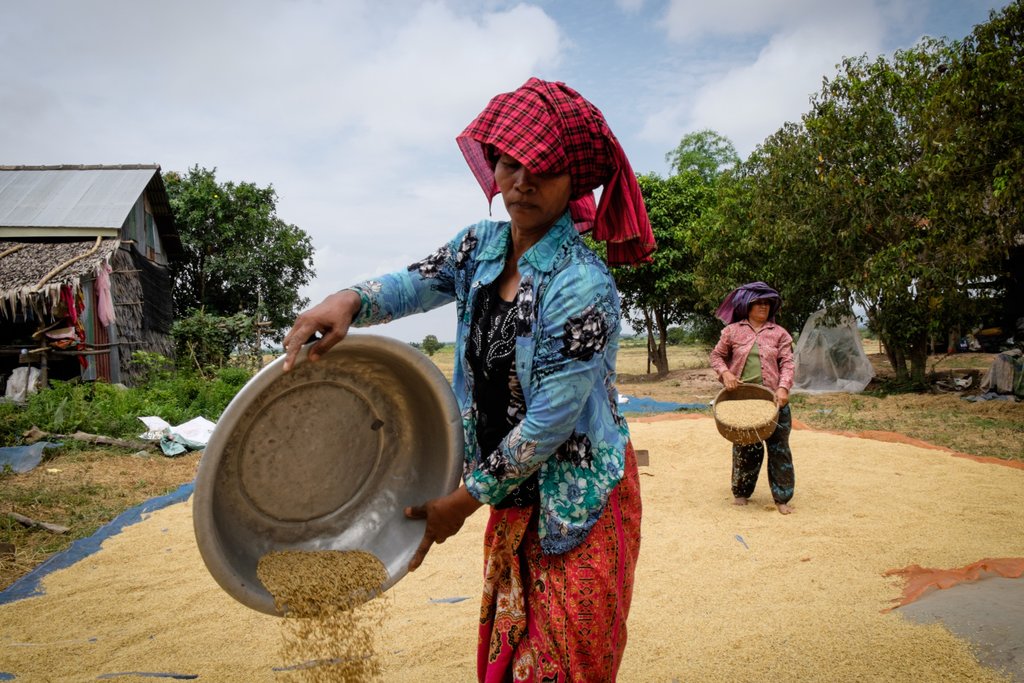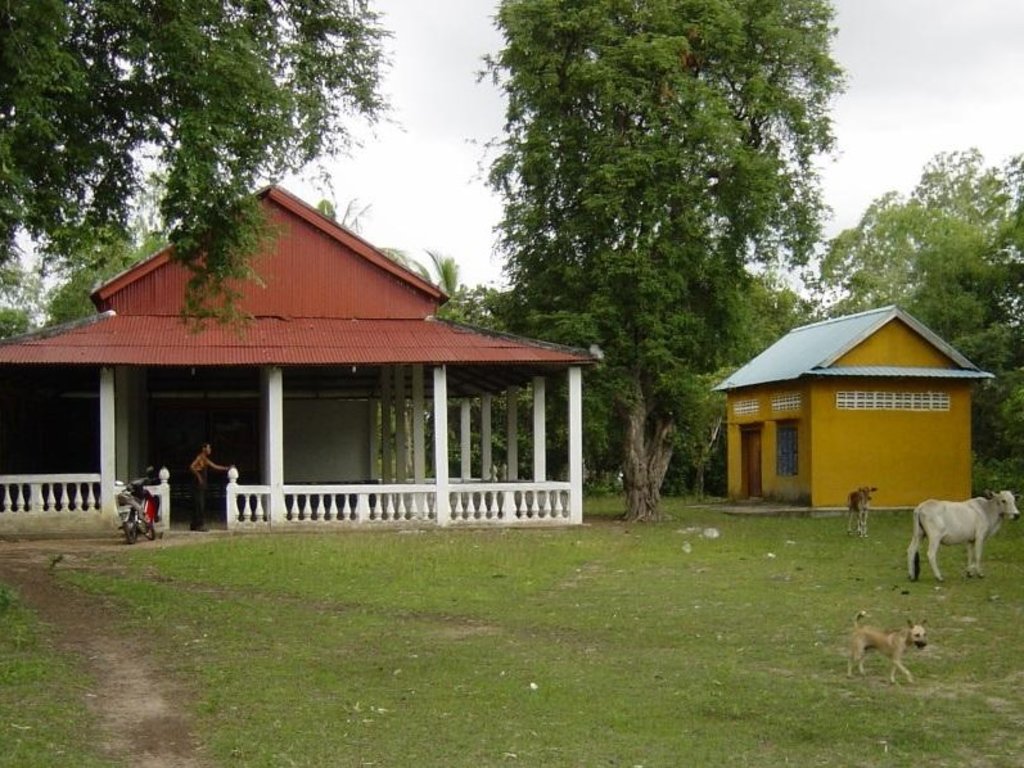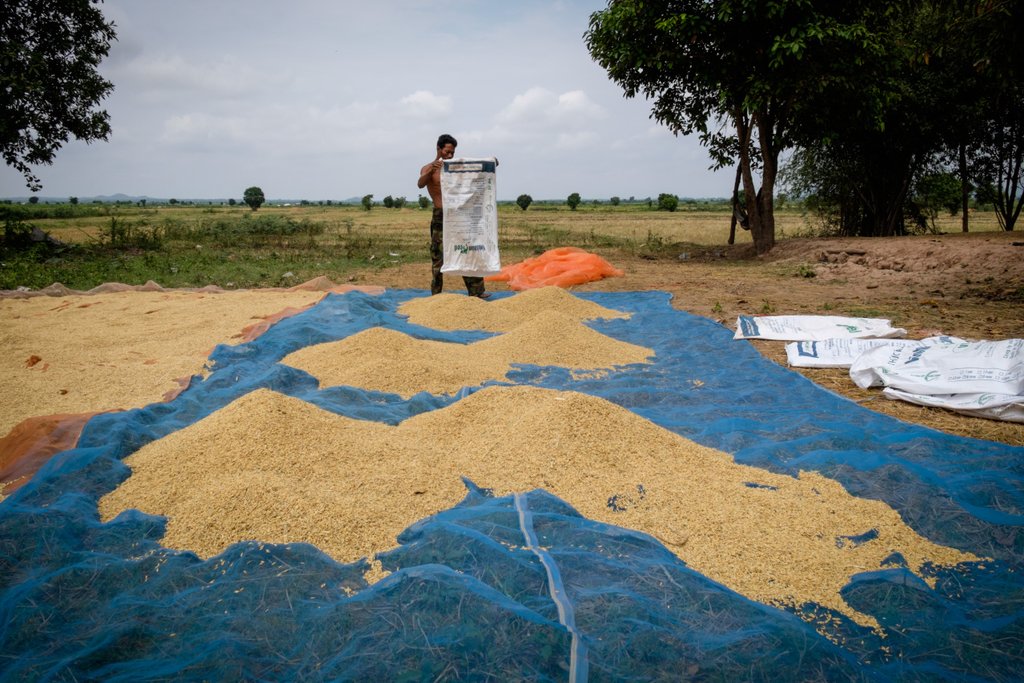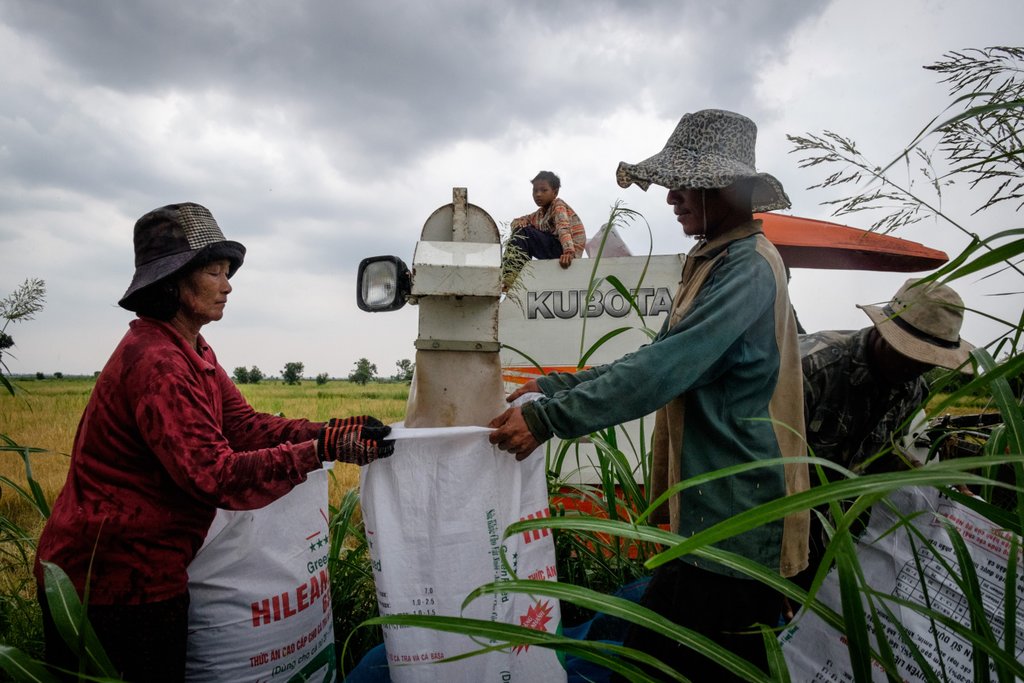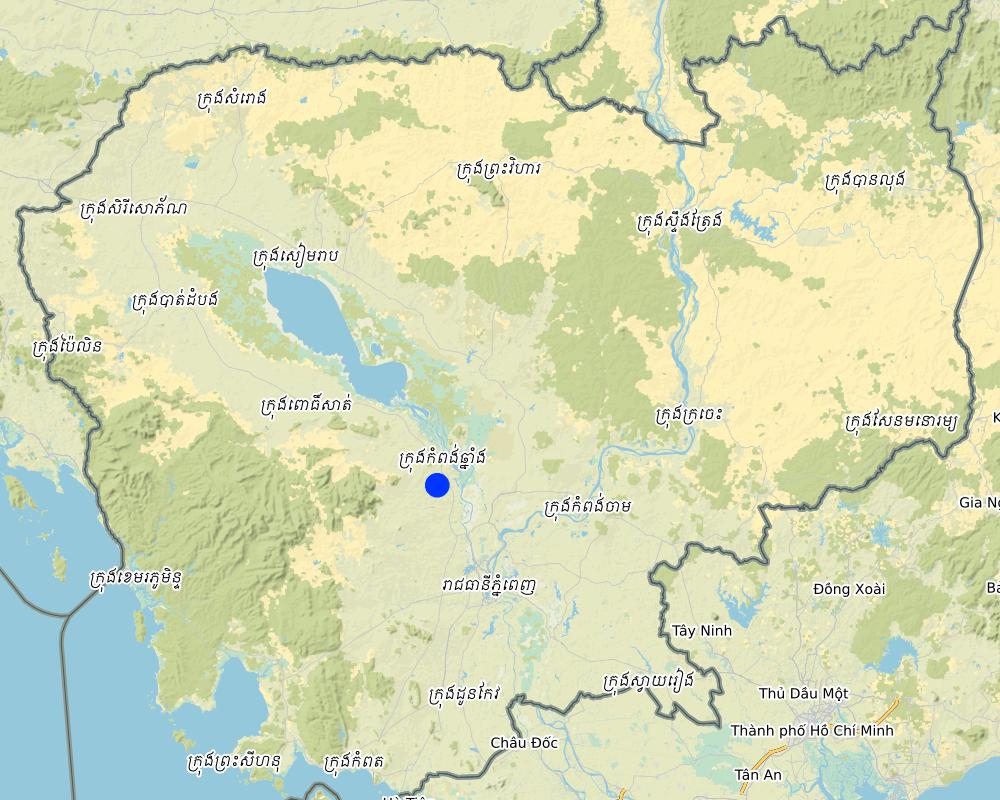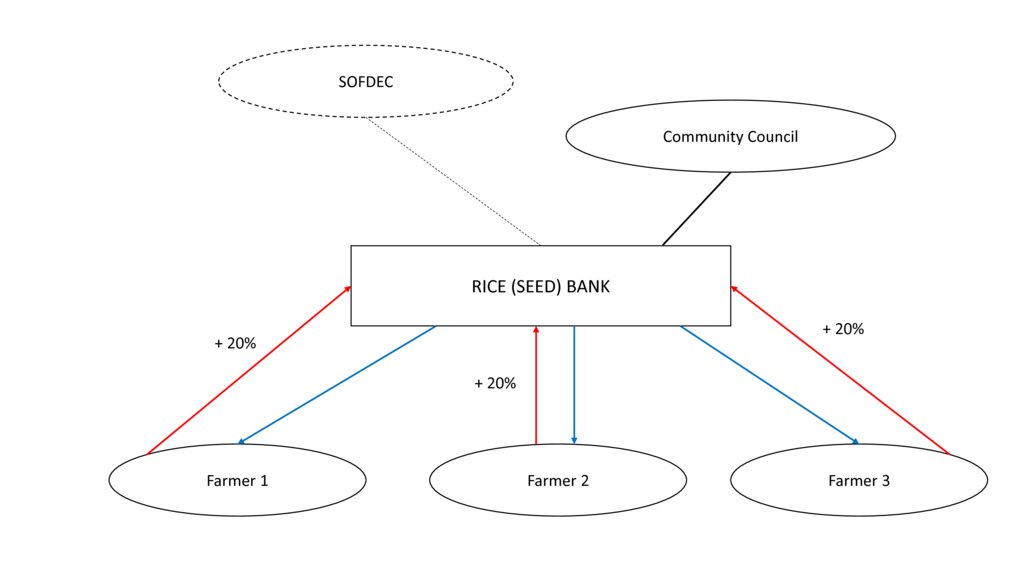Community Safety Nets - Establishment of rice seed banks at village level [ກໍາປູເຈຍ]
- ການສ້າງ:
- ປັບປູງ:
- ຜູ້ສັງລວມຂໍ້ມູນ: Stefan Graf
- ບັນນາທິການ: Stefan Graf, Christoph Kaufmann, Christine Lottje, Judith Macchi
- ຜູ້ທົບທວນຄືນ: Boris Orlowsky, Alexandra Gavilano, Judith Macchi
approaches_1848 - ກໍາປູເຈຍ
ເບິ່ງພາກສ່ວນ
ຂະຫຍາຍທັງໝົດ ຍຸບທັງໝົດ1. ຂໍ້ມູນທົ່ວໄປ
1.2 ລາຍລະອຽດ ການຕິດຕໍ່ ຂອງບຸກຄົນທີ່ຊັບພະຍາກອນ ແລະ ສະຖາບັນ ການມີສ່ວນຮ່ວມ ໃນການປະເມີນຜົນ ແລະ ເອກະສານ ຂອງວິທີທາງ
ບຸກຄົນສຳຄັນ (ຫຼາຍຄົນ)
ຜູ້ຊ່ຽວຊານ ດ້ານການຄຸ້ມຄອງ ທີ່ດິນແບບຍືນຍົງ:
Khun Lean Hak
kleanghak@yahoo.com / sofdec@camintel.com
SOFDEC/LAREC
ກໍາປູເຈຍ
ຜູ້ຊ່ຽວຊານ ດ້ານການຄຸ້ມຄອງ ທີ່ດິນແບບຍືນຍົງ:
Bin Sreytouch
Society for Community Development in Cambodia SOFDEC
ກໍາປູເຈຍ
Say Mesa
Society for Community Development in Cambodia SOFDEC
ກໍາປູເຈຍ
ຜູ້ຊ່ຽວຊານ ດ້ານການຄຸ້ມຄອງ ທີ່ດິນແບບຍືນຍົງ:
Pit Khonhel
Local Agriculture Research and Extension Centre LAREC
ກໍາປູເຈຍ
ຊື່ຂອງໂຄງການ ທີ່ອໍານວຍຄວາມສະດວກ ໃນການສ້າງເອກກະສານ ຫຼື ປະເມີນດ້ານແນວທາງ (ຖ້າກ່ຽວຂ້ອງ)
Book project: where people and their land are safer - A Compendium of Good Practices in Disaster Risk Reduction (DRR) (where people and their land are safer)1.3 ເງື່ອນໄຂ ຂອງການນໍາໃຊ້ເອກກະສານຂໍ້ມູນ ຂອງ WOCAT
ເມື່ອໃດທີ່ໄດ້ສັງລວມຂໍ້ມູນ (ຢູ່ພາກສະໜາມ)?
16/04/2014
ຜູ້ສັງລວມ ແລະ ບັນດາຜູ້ຕອບແບບສອບຖາມ ຍອມຮັບໃນເງື່ອນໄຂ ການນໍາໃຊ້ຂໍ້ມູນເອກະສານ ທີ່ສ້າງຂື້ນ ໂດຍຜ່ານ ອົງການ WOCAT:
ແມ່ນ
2. ພັນລະນາ ແນວທາງການຄຸ້ມຄອງນໍາໃຊ້ດິນແບບຍືນຍົງ
2.1 ການອະທິບາຍ ໂດຍຫຍໍ້ ຂອງວິທີທາງ
A rice (seed) bank is a community safety net system where farmers can get both rice seeds for cultivation and rice for consumption from a communal storage house in order to increase their food security by guaranteeing: (1) year-round access to high quality seeds and rice for consumption, (2) access to seed and rice for consumption after an extreme weather event (drought, flood) and (3) improved quality of the planted seeds through the provision of new varieties better adapted to local conditions (e.g. fast maturing, floating rice)
2.2 ການອະທິບາຍ ລາຍລະອຽດ ຂອງວິທີທາງ
ການອະທິບາຍ ລາຍລະອຽດ ຂອງວິທີທາງ:
A rice (seed) bank is a system where farmers can get both high quality rice seeds for planting and rice for consumption from a communal storage house. Requirement for the use of the rice (seed) bank is that farmers pay back the purchased rice seeds or rice for food with a 20% interest rate after their next harvest. The bank is managed by a community council consisting of members of the village in collaboration with the local NGO Society for Community Development in Cambodia - SOFDEC.
The rice (seed) banks act as a community safety net in the villages to guarantee food security despite the threat of extreme weather events such as drought or flood. Because of the constant access to high quality seeds, farmers can sow a second time in case the first sowing was lost due to a drought or flood. Also, the communal storage of rice for consumption helps particularly poor farmer families with small plots in case they do not get enough yield on their field to feed the household.
Moreover, new rice varieties, which are better adapted to local conditions and which also perform in the case of extreme weather (fast maturing, floating rice) are introduced through the rice (seed) bank. Besides these new varieties (the result of research carried out by the Local Agricultural Research and Extension Center LAREC in collaboration with other research institutes) have higher yields and can also be sold at a better price on the market.
The need for a rice (seed) bank is decided in participatory manner by the village community. In case a bank is established it is managed by a community council of elected community members. The council is responsible for the storage, the distribution and supervises the back payment of the rice (seed). Through the collaboration between the Community Council and SOFDEC, new SLM Technologies such as the System of Rice Intensification can be promoted in the target villages.
The stages of implementation are as follows:
1. SOFDEC consults with the villagers about the aim and the need for a rice (seed) bank. Generally, rice banks are established if farmers express that there is a high exposure to extreme weather event, low food security and/or rice seeds are of bad quality (bad germination, low yields).
2. The decision about the establishment and implementation of a rice (seed) bank is made by the village community.
3. A Community Council is elected by the villagers and trained on their role and functioning of the rice (seed) bank by SOFDEC staff.
4. The communal storage is built. Building materials are provided by SOFDEC, the community contributes with labor.
5. SOFDEC provides a first stock of high quality rice seeds from LAREC and rice for consumption.
6. After the first harvest, the farmers pay back the seeds and rice consumed with a 20% interest rate.
7. SOFDEC monitors the functioning of the rice seed banks and takes a mediating role in case that problems between the community council and the village community arises.
2.3 ຮູບພາບຂອງແນວທາງ
2.5 ປະເທດ / ເຂດ / ສະຖານທີ່ບ່ອນທີ່ແນວທາງໄດ້ຖືກນໍາໃຊ້
ປະເທດ:
ກໍາປູເຈຍ
ພາກພື້ນ / ລັດ / ແຂວງ:
Kampong Chhnang
ຂໍ້ມູນເພີ່ມເຕີມຂອງສະຖານທີ່:
Different districts
ຄວາມຄິດເຫັນ:
There are 11 rice banks in the area, benefitting 11 villages. The Society for Community Development in Cambodia (SOFDEC) has been implementing rice banks in different villages of Kampong Chhnang Province since 2000.
Map
×2.6 ວັນທີເລີ່ມຕົ້ນ ແລະ ສິ້ນສຸດ ການຈັດຕັ້ງປະຕີບັດ ວິທີທາງ
ສະແດງປີຂອງການເລີ່ມຕົ້ນ:
2000
2.7 ປະເພດຂອງແນວທາງ
- ພາຍໃຕ້ໂຄງການ / ແຜນງານ
2.8 ເປົ້າໝາຍ / ຈຸດປະສົງຫຼັກ ຂອງການຈັດຕັ້ງປະຕິບັດ ວິທີທາງ
The main aim of the approach is to increase the resilience of farmer families by improving their food security (rice seeds and rice for food are now available the whole year round, mutual support after droughts or floods possible), increasing their income (rice varieties higher yielding) as well as strengthening local institutions (community committees manage the rice banks, and participate in decision making on a local level).
2.9 ເງື່ອນໄຂອໍານວຍ ຫຼື ຂັດຂວາງການປະຕິບັດຂອງເຕັກໂນໂລຢີ / ເຕັກໂນໂລຢີການນໍາໃຊ້ຕາມແນວທາງ
ສັງຄົມ / ວັດທະນະທໍາ / ມາດຕະຖານ ແລະ ຄຸນຄ່າທາງສາສະໜາ
- ອໍານວຍ
Willingness of the community to support each other through a safety-net system
- ເຊື່ອງຊ້ອນ
Some farmers are reluctant to be part of the rice (seed) bank, as they do not want to use/consume someone else's rice, which might be of different quality than his/her own
ມີຄວາມສາມາດ / ເຂັ້າເຖິງຊັບພະຍາກອນດ້ານການເງິນ ແລະ ການບໍລິການ
- ອໍານວຍ
First inputs for the establishment of the rice (seed) banks are provided by the project (materials for the building of the bank, improved and locally adapted rice seed from LAREC)
- ເຊື່ອງຊ້ອນ
Some farmers struggle to repay the amount of rice borrowed including the requested interest rate of 20%, particularly after an extreme weather event (drought, flood)
ການຮ່ວມມື / ການປະສານງານຂອງຜູ້ກ່ຽວຂ້ອງ
- ອໍານວຍ
Rice (seed) banks are decided upon and managed by the community itself through an elected community council
ຄວາມຮູ້ກ່ຽວກັບການຄຸ້ມຄອງ ທີ່ດິນແບບຍືນຍົງ, ການເຂົ້າເຖິງການສະໜັບສະໜູນ ທາງດ້ານວິຊາການ
- ອໍານວຍ
Through research done by the Local Agricultural Research and Extension Center LAREC, the rice varieties in the rice banks are adapted to the needs of the farmers (e.g. higher yielding, short breeding, drought resistant). Through the SOFDEC programme farmers are furthermore capacitated in new cultivation techniques (such as System of Rice Intensification - SRI).
- ເຊື່ອງຊ້ອນ
Lack of technical knowlegde on high quality seed multiplication leads to rice seed supply of bad quality in the rice bank.
3. ການມີສ່ວນຮ່ວມ ແລະ ບົດບາດຂອງພາກສ່ວນທີ່ກ່ຽວຂ້ອງທີ່ໄດ້ມີສ່ວນຮ່ວມ
3.1 ຜູ້ມີສ່ວນຮ່ວມ ໃນວິທີທາງ ແລະ ພາລະບົດບາດ ຂອງເຂົາເຈົ້າ
- ຜູ້ນໍາໃຊ້ດິນໃນທ້ອງຖິ່ນ / ຊຸມຊົນທ້ອງຖິ່ນ
Farmers
Farmers can borrow rice seed and in case of a disaster also rice for consumption from the rice bank. After their next harvest the farmers have to pay back the rice (seed) borrowed with a 20% interest
- ອົງການຈັດຕັ້ງ ພາຍໃນຊຸມຊົນ
Community council
Community Councils are elected by the community and are managing the rice banks and make sure that the regulation are met by the farmers participating in the rice banks
- ອົງການຈັດຕັ້ງ ທີ່ບໍ່ຂື້ນກັບລັດຖະບານ
Society for Community Development in Cambodia - SOFDEC
SOFDEC is responsible for the planning and design of the approach, implementation of rice banks as well as for the financing of the initial establishment of the rice banks.
- ອໍານາດ ການປົກຄອງທ້ອງຖິ່ນ
village chief
The village chief facilitates the introduction of the rice seed bank in the community and supports the community council in the steering of the banks as well as when facing problems within the village concerning the bank.
Furthermore, the village chief has to verify and acknowledge land acquisation documents land for rice bank construction and by-laws.
ຖ້າຫາກມີຫຼາຍພາກສ່ວນທີ່ເຂົ້າຮ່ວມ ໃຫ້ລະບຸ ອົງການທີ່ເປັນຫຼັກ ໃນການຈັດຕັ້ງປະຕິບັດ:
SOFDEC
3.2 ການມີສ່ວນຮ່ວມຂອງຜູ້ນໍາໃຊ້ທີ່ດິນໃນທ້ອງຖິ່ນ / ຊຸມຊົນທ້ອງຖິ່ນໃນໄລຍະທີ່ແຕກຕ່າງກັນຂອງແນວທາງ
| ການລວບລວມ ເອົາຜູ້ນໍາໃຊ້ດິນ ໃນທ້ອງຖິ່ນ / ຊຸມຊົນທ້ອງຖິ່ນ | ໃຫ້ລະບຸ ຜູ້ໃດທີ່ມີສ່ວນຮ່ວມ ໃນແຕ່ລະກິດຈະກໍາ? | |
|---|---|---|
| ການເລີ່ມຕົ້ນ / ແຮງຈູງໃຈ | ການຮ່ວມມື | Land users are consulted regarding their needs for the establishment of a rice bank. |
| ການວາງແຜນ | ການບໍ່ປະຕິບັດ | The planning and design of the rice banks is carried out by SOFDEC staff. |
| ການປະຕິບັດ | ການຊ່ວຍເຫຼືອຈາກພາຍນອກ | Implementation of the banks is done by SOFDEC in consultation with the land users. SOFDEC finances the materials for the establishment of the rice banks, whereas the community contributes with their labor. Community agrees on the regulations (by-laws) for the implementation of the rice banks. |
| ຕິດຕາມກວດກາ / ການປະເມີນຜົນ | ການຮ່ວມມື | SOFDEC initially monitors the functioning of the rice banks (3-4 years after establishment). The community council is responsible for the everyday monitoring of the banks (e.g. participating farmers adhere to the regulations agreed on by the community). |
| research | ການບໍ່ປະຕິບັດ | Research for improved locally adapted rice varieties (fast maturing, floating rice) is done by Local Agricultural Research and Extension Center- LAREC in collaboration with other research institutions. The improved seed developed by LAREC is stocked in the rice seed banks. |
3.3 ແຜນວາດ (ຖ້າມີ)
ການອະທິບາຍ:
Rice (seed) banks are established on a village level after consultation with the local farming community. The banks are managed by an elected community council. Farmers take out rice seed or rice for consumption (in case of an emergency) and pay back the amount of rice (seed) with an interest rate of 20%.
SOFDEC facilitates the establishment of the rice seed banks and provides the material for the building of the rice seed bank as well as the first supply of rice seed.
ຜູ້ຂຽນ:
HEKS
3.4 ການຕັດສິນໃຈກ່ຽວກັບການຄັດເລືອກເຕັກໂນໂລຢີຂອງການຄຸ້ມຄອງທີ່ດິນແບບຍືນຍົງ / ເຕັກໂນໂລຢີ
ລະບຸ ຄົນທີ່ຕັດສິນໃຈ ກ່ຽວກັບການຄັດເລືອກຂອງ ເຕັກໂນໂລຢີ / ເຕັກໂນໂລຢີ ຈະໄດ້ຮັບການປະຕິບັດ:
- ຜູ້ນໍາໃຊ້ທີ່ດິນຫຼັກ, ການສະໜັບສະໜູນ ໂດຍຜູ້ຊ່ຽວຊານ ການນໍາໃຊ້ທີ່ດິນແບບຍືນຍົງ
- n.a.
4. ການສະໜັບສະໜູນທາງດ້ານວິຊາການ, ການສ້າງຄວາມສາມາດ, ແລະ ການຈັດການຄວາມຮູ້.
4.1 ການສ້າງຄວາມສາມາດ / ການຝຶກອົບຮົມ
ຜູ້ນໍາໃຊ້ທີ່ດິນ ຫຼື ພາກສ່ວນກ່ຽວຂ້ອງອື່ນໆ ໄດ້ຮັບການຝຶກອົບຮົມບໍ່?
ແມ່ນ
ໃຫ້ລະບຸ ຜູ້ໃດທີ່ໄດ້ຮັບການຝຶກອົບຮົມ:
- ຜູ້ນໍາໃຊ້ດິນ
ຖ້າເປັນໄປໄດ້, ໃຫ້ລະບຸເພດ, ອາຍຸ, ສະຖານະພາບ, ຊົນເຜົ່າ, ແລະ ອື່ນໆ:
Community Councils and participating farmers
ຮູບແບບຂອງການຝຶກອົບຮົມ:
- ການເຮັດຕົວຈິງ
ໃນຫົວຂໍ້:
Community councils were trained on functioning and administration of the rice bank. Farmers were trained on the multiplication and collection of rice seeds.
4.2 ການບໍລິການໃຫ້ຄໍາປຶກສາ
ເຮັດຜູ້ໃຊ້ທີ່ດິນມີການເຂົ້າເຖິງການບໍລິການໃຫ້ຄໍາປຶກສາ?
ແມ່ນ
- n.a.
ອະທິບາຍ / ຄວາມຄິດເຫັນ:
Knowledge exchange between the land users and SOFDEC staff.
Knowledge exchange between SOFDEC and the Provincial Department of Agriculture.
4.3 ສະຖາບັນການສ້າງຄວາມເຂັ້ມແຂງ (ການພັດທະນາອົງການຈັດຕັ້ງ)
ສະຖາບັນ ໄດ້ຮັບການສ້າງຕັ້ງຂື້ນ ຫຼື ໄດ້ຮັບການສ້າງຄວາມເຂັ້ມແຂງ ໂດຍການຈັດຕັ້ງປະຕິບັດ ວິທີທາງບໍ່?
- ມີ, ພໍສົມຄວນ
ລະບຸ ທາງສະຖາບັນ ໄດ້ສ້າງຄວາມເຂັ້ມແຂງ ໃນລະດັບໃດ (ຫຼາຍ):
- ທ້ອງຖິ່ນ
ອະທິບາຍ ສະຖາບັນການຈັດຕັ້ງ, ພາລະບົດບາດ ແລະ ໜ້າທີ່ຮັບຜິດຊອບ, ສະມາຊິກ ແລະ ອື່ນໆ.
Community Councils
ລະບຸ ປະເພດ ຂອງສະໜັບສະໜູນ:
- ການສ້າງຄວາມອາດສາມາດ / ການຝຶກອົບຮົມ
4.4 ຕິດຕາມກວດກາ ແລະ ປະເມີນຜົນ
ການຈັດຕັ້ງປະຕິບັດ ວິທີທາງ ໄດ້ມີການປະເມີນຜົນ ແລະ ຕິດຕາມບໍ?
ແມ່ນ
ຄວາມຄິດເຫັນ:
Everyday monitoring is ensured by the community council.
For the first 3-4 years after the establishment, SOFDEC monitors the implementation and functioning of the rice banks.
Monitoring aspects:
- No. of members, kg of rice taken out of the bank and payed back to the bank
- General attitude towards the rice bank (are the pay back mechanisms adhered to, etc.)
- Amount of yields and quality of rice (seeds), sometimes optimized
ຖ້າແມ່ນ, ເອກກະສານສະບັບນີ້ ແມ່ນໄດ້ນໍາໃຊ້ເຂົ້າໃນການຕິດຕາມ ແລະ ປະເມີນຜົນບໍ່?
ແມ່ນ
4.5 ການຄົ້ນຄວ້າ
ນີ້້ແມ່ນສ່ວນໜຶ່ງ ການຄົ້ນຄວ້າ ຂອງວິທີທາງບໍ່?
ບໍ່ແມ່ນ
5. ການສະໜັບສະໜູນທາງດ້ານການເງິນ ແລະ ອຸປະກອນຈາກພາຍນອກ
5.1 ງົບປະມານປະຈໍາປີ ສໍາລັບວິທີທາງ ຂອງການຄຸ້ມຄອງ ທີ່ດິນແບບຍືນຍົງ
ຖ້າຫາກບໍ່ຮູ້ຈັດງົບປະມານທີ່ແນ່ນອນ ແມ່ນໃຫ້ປະມານເອົາ:
- 2,000-10,000
5.2 ການສະໜັບສະໜູນ ທາງດ້ານການເງິນ / ອຸປະກອນ ສະໜອງໃຫ້ແກ່ຜູ້ນໍາທີ່ດິນ
ຜູ້ນໍາໃຊ້ດິນ ໄດ້ຮັບການສະໜັບສະໜູນ ທາງດ້ານ ການເງິນ / ອຸປະກອນ ໃນການຈັດຕັ້ງປະຕິບັດ ເຕັກໂນໂລຢີບໍ?
ແມ່ນ
ຖ້າແມ່ນ, ໃຫ້ລະບຸປະເພດ (ຫຼາຍ) ຂອງການສະໜັບສະໜູນ, ເງື່ອນໄຂ ແລະ ຜູູ້ສະໜອງ (ຫຼາຍ):
The project provides the materials for for rice bank construction.
5.3 ເງິນສົມທົບສໍາລັບການນໍາໃຊ້ສະເພາະປັດໃຈຂາເຂົ້າໃນການຜະລີດກະສິກໍາ (ລວມທັງແຮງງານ)
- ກະສິກໍາ
| ໃຫ້ລະບຸໄດ້ຮັບການສະໜັບສະໜູນປັດໃຈຂາເຂົ້າຫຍັງແດ່ | ທີ່ຂອບເຂດ | ລະບຸ ການອຸດໜູນ |
|---|---|---|
| ແນວພັນ, ແກ່ນພັນ | ງົບປະມານເຕັມສ່ວນ | Rice seeds for the first season after the implementation of the rice bank is provided by the project. |
- ການກໍ່ສ້າງ
| ໃຫ້ລະບຸໄດ້ຮັບການສະໜັບສະໜູນປັດໃຈຂາເຂົ້າຫຍັງແດ່ | ທີ່ຂອບເຂດ | ລະບຸ ການອຸດໜູນ |
|---|---|---|
| ຫີນ | ງົບປະມານເຕັມສ່ວນ | All construction materials for the rice bank building is provided by the project. Type of construction (wood or stone) varied depending on the preferences of the village community. |
| ໄມ້ | ງົບປະມານເຕັມສ່ວນ | All construction materials for the rice bank building is provided by the project. Type of construction (wood or stone) varied depending on the preferences of the village community. |
ຖ້າແຮງງານ ຂອງຜູ້ນໍາໃຊ້ດິນ ໄດ້ຮັບການສະໜັບສະໜູນ ປັດໃຈຂາເຂົ້າ, ແມ່ນບໍ່:
- ການອາສາ
ຄວາມຄິດເຫັນ:
Land users supported the establishment of the rice seed banks with their labor.
5.4 ສິນເຊື່ອ
ໄດ້ປ່ອຍສິນເຊື່ອ ສະໜອງໃຫ້ພາຍໃຕ້ ວິທີການສໍາລັບກິດຈະກໍາ ການຄຸ້ມຄອງ ທີ່ດິນແບບຍືນນຍົງບໍ່?
ບໍ່ແມ່ນ
5.5 ສິ່ງຈູງໃຈ ຫຼື ເຄື່ອງມືອື່ນໆ
ການສົ່ງເສີມ ຈັດຕັ້ງປະຕິບັດ ເຕັກໂນໂລຢີ ໃນການຄຸ້ມຄອງ ດິນແບບຍືນຍົງ ໄດ້ສະໜອງສິ່ງກະຕຸກຊຸກຍູ້ບໍ່?
ບໍ່ແມ່ນ
6. ວິເຄາະຜົນກະທົບ ແລະ ສັງລວມບັນຫາ
6.1 ຜົນກະທົບຂອງແນວທາງ
ການຈັດຕັ້ງປະຕິບັດ ວິທີທາງ ສາມາດຊ່ວຍຜູ້ນໍາໃຊ້ທີ່ດິນ ໃນການຈັດຕັ້ງປະຕິບັດ ແລະ ບໍາລຸງຮັກສາ ເຕັກໂນໂລຢີ ການຄຸ້ມຄອງ ທີ່ດິນແບບຍືນຍົງໄດ້ບໍ?
- ບໍ່
- ມີ, ໜ້ອຍໜຶ່ງ
- ມີ, ພໍສົມຄວນ
- ມີ, ຫຼາຍ
Farmers have access to seed varieties which are adapted to local conditions (e.g. drought and flood resistance), ensuring that yields are also generated in case of an extreme weather event.
ການຈັດຕັ້ງປະຕິບັດ ວິທີທາງ ສາມາດສ້າງຄວາມເຂັ້ມແຂງ ທາງສັງຄົມ ແລະ ເສດຖະກິດບໍ່?
- ບໍ່
- ມີ, ໜ້ອຍໜຶ່ງ
- ມີ, ພໍສົມຄວນ
- ມີ, ຫຼາຍ
Rice (seed) banks are open to everybody. Thus, economically disadvantaged land users and ethnic minorities participate in rice banks. The rice banks function as safety nets in cases of extreme weather (e.g. droughts, floods) or economic despair.
ການນໍາໃຊ້ ວິທີທາງ ໄດ້ປັບປຸງ ການຄໍ້າປະກັນສະບຽງອາຫານ ຫຼື ປັບປຸງໂຄສະນາການໄດ້ບໍ່?
- ບໍ່
- ມີ, ໜ້ອຍໜຶ່ງ
- ມີ, ພໍສົມຄວນ
- ມີ, ຫຼາຍ
The rice banks offer year round access to high quality rice seed and rice for consumption all year round and also during extreme weather events. This allows farmers to sow out again in case one harvest gets lost. The rice bank also benefits farmers with small land plots – they might sell all their yields of new varieties on the market and buy with the return conventional rice for consumption, which is cheaper.
ການຈັດຕັ້ງປະຕິບັດ ວິທີທາງ ສາມາດສ້າງຄວາມອາດສາມາດໃຫ້ຜູ້ນໍາໃຊ້ດິນ ໃນການປັບຕົວ ຕໍ່ການປ່ຽນແປງດິນຟ້າອາກາດ / ຫຼດຜ່ອນຄວາມສ່ຽງທາງໄພພິບັດໄດ້ບໍ? :
- ບໍ່
- ມີ, ໜ້ອຍໜຶ່ງ
- ມີ, ພໍສົມຄວນ
- ມີ, ຫຼາຍ
Increased resilience to extreme weather events because of the availability of both seeds and rice for consumption. Moreover, the seed varieties stored in the rice bank is adapted to local conditions (e.g. fast maturing, floating rice), ensuring that yields are also generated in case of an extreme weather event.
ການນໍາໃຊ້ ວິທີທາງ ໄດ້ປັບປຸງ ການຈ້າງງານ, ໂອກາດ ໃນການສ້າງລາຍຮັບບໍ່?
- ບໍ່
- ມີ, ໜ້ອຍໜຶ່ງ
- ມີ, ພໍສົມຄວນ
- ມີ, ຫຼາຍ
The new varieties promoted through the rice banks have higher yields, thus leading to more income for the farmers. Farmers also get higher prices on the market for the new rice varieties.
6.2 ແຮງຈູງໃຈຫຼັກຂອງຜູ້ນໍາໃຊ້ທີ່ດິນໃນການປະຕິບັດການຄຸ້ມຄອງທີ່ດິນແບບຍືນຍົງ
- ການຜະລິດເພີ່ມຂຶ້ນ
- ຫຼຸດຜ່ອນຄວາມສ່ຽງຂອງໄພພິບັດ
- well-being and livelihoods improvement
6.3 ຄວາມຍືນຍົງຂອງກິດຈະກໍາວິທີທາງ
ຜູ້ນໍາໃຊ້ ທີ່ດິນ ສາມາດສືບຕໍ່ ການຈັດຕັ້ງປະຕິບັດ ຜ່ານວິທີທາງໄດ້ບໍ່ (ໂດຍປາດສະຈາກ ການຊ່ວຍເຫຼືອ ຈາກພາກສ່ວນພາຍນອກ)?
- ແມ່ນ
ຖ້າ ໄດ້, ອະທິບາຍເຫດຜົນ:
Initial coaching by SOFDEC is needed, however, after 3 years the rice banks function without any external support.
6.4 ຈຸດແຂງ / ຂໍ້ດີ ຂອງວິທີທາງ
| ຈຸດແຂງ / ຂໍ້ດີ / ໂອກາດໃນການນໍາໃຊ້ທີ່ດິນ |
|---|
| The rice banks offer access to high quality seeds to all farmers in the community. |
|
Increased food security and resilience due to the permanent availability of rice seeds or rice for consumption. |
| More income due to higher yields and better prices for new varieties. |
| After about 3-4 years, the banks mostly work independently. |
6.5 ຈຸດອ່ອນ / ຂໍ້ເສຍຂອງແນວທາງ ແລະ ວິທີການແກ້ໄຂໃຫ້ເຂົາເຈົ້າ
| ຈຸດອ່ອນ / ຂໍ້ເສຍ / ຄວາມສ່ຽງໃນມູມມອງຂອງຜູ້ນໍາໃຊ້ທີ່ດິນ | ມີວິທີການແກ້ໄຂຄືແນວໃດ? |
|---|---|
| Limited amount of rice (seed) to be borrowed. | Increase the storage capacity and conditions. |
| Required technical and managerial knowledge for the community councils is high. | Regular training sessions by SOFDEC |
| Rodents or insects might destroy the rice. | Apply narrow-mash nets to protect the rice from rodents and other animals |
| Some farmers do not comply with the required interest rates, delays in payback, etc. | Make a contract with them, decide on a step by step pay back manner, or if the farmer is not able repay (sick family member, loss of land, etc.) the whole group can decide to waive the debts |
| ຈຸດອ່ອນ ຫຼື ຂໍ້ເສຍ ຫຼື ຄວາມສ່ຽງ ໃນມຸມມອງຂອງ ຜູ້ສັງລວມຂໍ້ມູນ ຫຼື ບັນດາຜູ້ຕອບແບບສອບຖາມ | ມີວິທີການແກ້ໄຂຄືແນວໃດ? |
|---|---|
| Seeds are treated with pesticides to make them last. | Improve the storage conditions or use different techniques to prevent pests (Integrated Pest Management IPM) |
| Only rice is considered. | Introduce a similar approach also for other plants in order to diversify the farmers’ income. Allow the farmer to pay back with other crops or varieties. |
7. ເອກກະສານອ້າງອີງ ແລະ ຂໍ້ມູນການເຊື່ອມໂຍງ
7.1 ວິທີການ / ແຫຼ່ງຂໍ້ມູນ
- ການໄປຢ້ຽມຢາມພາກສະໜາມ, ການສໍາຫຼວດພາກສະໜາມ
- ການສໍາພາດ ຜູ້ນໍາໃຊ້ທີ່ດິນ
- ການລວບລວມ ບົດລາຍງານ ແລະ ເອກະສານອື່ນໆ ທີ່ມີຢູ່ແລ້ວ
7.3 ການເຊື່ອມຕໍ່ກັບຂໍ້ມູນທີ່ກ່ຽວຂ້ອງທີ່ສາມາດໃຊ້ອອນໄລນ໌
ຫົວຂໍ້ / ພັນລະນາ:
The Society for Community Development in Cambodia (SOFDEC) is a Cambodian Non-Governmental Organization, established in 2006 through the localization of HEKS (the Swiss Church Aid) project in Kampong Chhnang province, Cambodia. The vision of SOFDEC is that Cambodian people living in Cambodia live a state of comfort, equality, equity, and have ownership over the sustainable development of their community. The mission of SOFDEC works in partnership with community based organizations and relevant institutions through integrated community development, research, human resource development, enhancement of family economies, in the hopes to uplift the living standards of the people in the target areas. Our goal aims to uplift the living standards of the rural people of Cambodia through the improvement in income generation, sustainable agricultural practices, microfinance, health, human resource development, and sustainable natural resource management.
URL:
www.sofdec.com
ຂໍ້ມູນການເຊື່ອມຕໍ່ ແລະ ເນື້ອໃນ
ຂະຫຍາຍທັງໝົດ ຍຸບທັງໝົດການເຊື່ອມຕໍ່
ບໍ່ມີຂໍ້ມູນການເຊື່ອມຕໍ່
ເນື້ອໃນ
ບໍ່ມີເນື້ອໃນ



